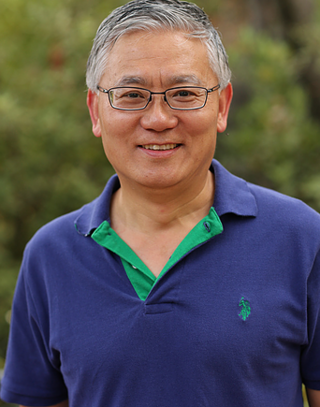
Jakob Nielsen is a Danish web usability consultant, human–computer interaction researcher, and co-founder of Nielsen Norman Group. He was named the “guru of Web page usability” in 1998 by The New York Times and the “king of usability” by Internet Magazine.

User interface (UI) design or user interface engineering is the design of user interfaces for machines and software, such as computers, home appliances, mobile devices, and other electronic devices, with the focus on maximizing usability and the user experience. In computer or software design, user interface (UI) design primarily focuses on information architecture. It is the process of building interfaces that clearly communicate to the user what's important. UI design refers to graphical user interfaces and other forms of interface design. The goal of user interface design is to make the user's interaction as simple and efficient as possible, in terms of accomplishing user goals.

Citadel is a collaboration suite that is directly descended from the Citadel family of programs which became popular in the 1980s and 1990s as a bulletin board system platform. It is designed to run on open source operating systems such as Linux or BSD. Although it is being used for many bulletin board systems, in 1998 the developers began to expand its functionality to a general purpose groupware platform.

Presentation–abstraction–control (PAC) is a software architectural pattern. It is an interaction-oriented software architecture, and is somewhat similar to model–view–controller (MVC) in that it separates an interactive system into three types of components responsible for specific aspects of the application's functionality. The abstraction component retrieves and processes the data, the presentation component formats the visual and audio presentation of data, and the control component handles things such as the flow of control and communication between the other two components.
End-user development (EUD) or end-user programming (EUP) refers to activities and tools that allow end-users – people who are not professional software developers – to program computers. People who are not professional developers can use EUD tools to create or modify software artifacts and complex data objects without significant knowledge of a programming language. In 2005 it was estimated that by 2012 there would be more than 55 million end-user developers in the United States, compared with fewer than 3 million professional programmers. Various EUD approaches exist, and it is an active research topic within the field of computer science and human-computer interaction. Examples include natural language programming, spreadsheets, scripting languages, visual programming, trigger-action programming and programming by example.
User experience design defines the experience a user would go through when interacting with a company, its services, and its products. User experience design is a user centered design approach because it considers the user's experience when using a product or platform. Research, data analysis, and test results drive design decisions in UX design rather than aesthetic preferences and opinions. Unlike user interface design, which focuses solely on the design of a computer interface, UX design encompasses all aspects of a user's perceived experience with a product or website, such as its usability, usefulness, desirability, brand perception, and overall performance. UX design is also an element of the customer experience (CX), and encompasses all aspects and stages of a customer's experience and interaction with a company.
James David Foley is an American computer scientist and computer graphics researcher. He is a Professor Emeritus and held the Stephen Fleming Chair in Telecommunications in the School of Interactive Computing at Georgia Institute of Technology. He was Interim Dean of Georgia Tech's College of Computing from 2008–2010. He is perhaps best known as the co-author of several widely used textbooks in the field of computer graphics, of which over 400,000 copies are in print and translated in ten languages. Foley most recently conducted research in instructional technologies and distance education.

GroupLens Research is a human–computer interaction research lab in the Department of Computer Science and Engineering at the University of Minnesota, Twin Cities specializing in recommender systems and online communities. GroupLens also works with mobile and ubiquitous technologies, digital libraries, and local geographic information systems.

Human–computer interaction (HCI) is research in the design and the use of computer technology, which focuses on the interfaces between people (users) and computers. HCI researchers observe the ways humans interact with computers and design technologies that allow humans to interact with computers in novel ways. A device that allows interaction between human being and a computer is known as a "Human-computer Interface (HCI)".
User experience evaluation (UXE) or user experience assessment (UXA) refers to a collection of methods, skills and tools utilized to uncover how a person perceives a system before, during and after interacting with it. It is non-trivial to assess user experience since user experience is subjective, context-dependent and dynamic over time. For a UXA study to be successful, the researcher has to select the right dimensions, constructs, and methods and target the research for the specific area of interest such as game, transportation, mobile, etc.

Elizabeth Frances Churchill is a British American psychologist specializing in human-computer interaction (HCI) and social computing. She is a Director of User Experience at Google. She has held a number of positions in the ACM including Secretary Treasurer from 2016 to 2018, and Executive Vice President from 2018 to 2020.

Marti Hearst is a professor in the School of Information at the University of California, Berkeley. She did early work in corpus-based computational linguistics, including some of the first work in automating sentiment analysis, and word sense disambiguation. She invented an algorithm that became known as "Hearst patterns" which applies lexico-syntactic patterns to recognize hyponymy (ISA) relations with high accuracy in large text collections, including an early application of it to WordNet; this algorithm is widely used in commercial text mining applications including ontology learning. Hearst also developed early work in automatic segmentation of text into topical discourse boundaries, inventing a now well-known approach called TextTiling.
Victoria Bellotti is a Senior CI researcher in the Member Experience Team at Netflix. Previously, she was a user experience manager for growth at Lyft and a research fellow at the Palo Alto Research Center. She is known for her work in the area of personal information management and task management, but from 2010 to 2018 she began researching context-aware peer-to-peer transaction partner matching and motivations for using peer-to-peer marketplaces which led to her joining Lyft. Victoria also serves as an adjunct professor in the Jack Baskin School of Engineering at University of California Santa Cruz, on the editorial board of the Personal and Ubiquitous Computing and as an associate editor for the International Journal of HCI. She is a researcher in the Human–computer interaction community. In 2013 she was awarded membership of the ACM SIGCHI Academy for her contributions to the field and professional community of human computer interaction.
S. Joy Mountford is known for her work in the field of computer-human interaction and interface design. From 1986 to 1994, she was Head of the Human Interface Group at Apple Computer where she helped developing QuickTime. In 2012, Mountford won the Lifetime Practice Award from SIGCHI and joined the CHI Academy.

Mormedi is a strategic design and innovation consultancy founded in 1998 by Jaime Moreno. The company is headquartered in Madrid, with a presence in Mexico City and Tokyo. Moreno describes the company as a “global boutique” as the majority of the company’s clients are outside of Spain, with the EU, USA, Latin America, Japan, and Korea being major markets.
Sharon Oviatt is an internationally recognized computer scientist, professor and researcher known for her work in the field of human–computer interaction on human-centered multimodal interface design and evaluation.

Shumin Zhai is a Chinese-born American Canadian Human–computer interaction (HCI) research scientist and inventor. He is known for his research specifically on input devices and interaction methods, swipe-gesture-based touchscreen keyboards, eye-tracking interfaces, and models of human performance in human-computer interaction. His studies have contributed to both foundational models and understandings of HCI and practical user interface designs and flagship products. He previously worked at IBM where he invented the ShapeWriter text entry method for smartphones, which is a predecessor to the modern Swype keyboard. Dr. Zhai's publications have won the ACM UIST Lasting Impact Award and the IEEE Computer Society Best Paper Award, among others, and he is most known for his research specifically on input devices and interaction methods, swipe-gesture-based touchscreen keyboards, eye-tracking interfaces, and models of human performance in human-computer interaction. Dr. Zhai is currently a Principal Scientist at Google where he leads and directs research, design, and development of human-device input methods and haptics systems.

Payal Arora is a digital anthropologist, author, and Professor and holds the Chair in Inclusive AI Cultures at Utrecht University. She is the co-founder of FemLab, a feminist future of work initiative. Her work focuses on internet usage in the Global South, specifically on global digital cultures, inequality and data governance. She is Indian, American, and Irish and currently lives in Amsterdam.
Jofish Kaye is an American and British scientist specializing in human-computer interaction and artificial intelligence. He runs interaction design and user research at anthem.ai, and is an editor of Personal & Ubiquitous Computing.
Design justice is the ethical and inclusive approach to designing products or systems that address and mitigate historical inequalities to ensure fair and equitable outcomes for all users. The article covers an overview of design justice, the 10 Principles of Design Justice, challenges in equitable design, and applications of design justice in Artificial Intelligence and Human-Computer Interaction.











